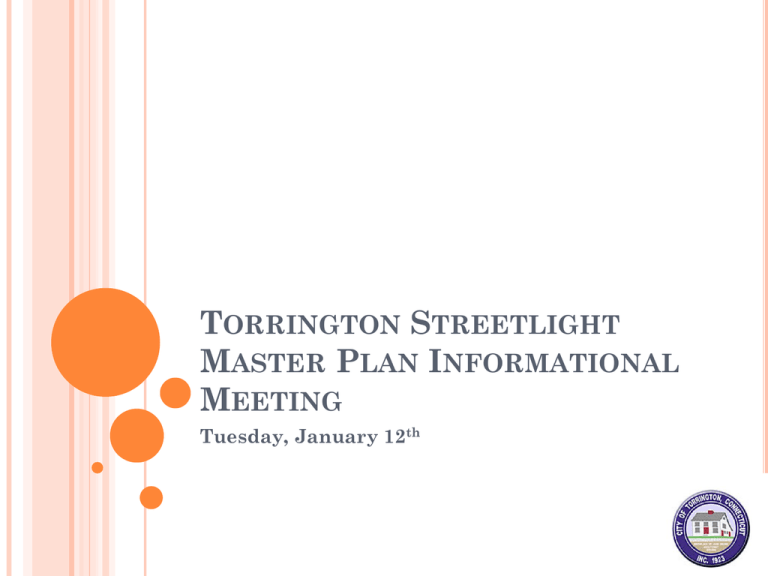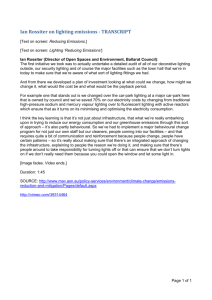Streetlight Powerpoint - The City of Torrington, CT
advertisement

TORRINGTON STREETLIGHT MASTER PLAN INFORMATIONAL MEETING Tuesday, January 12th WHAT IS THE PURPOSE OF THIS MEETING? Present the Streetlight Master Plan, as it currently exists, to residents and businesses. Gain constructive feedback from residents Outcome: To develop a Streetlight Master Plan that best meets the street lighting needs of our community TONIGHT’S AGENDA 6:30-7:15 – Presentation 7:15-7:45 – Question & Answer History of Streetlights in Torrington Advancements in technology that have made roads safer in the past decade Background of Streetlight Master Plan and Policy Process in which the Streetlight Master Plan is being created Goals, Timing & Next Steps Answer Questions which the City has already received Audience ask additional questions to panel of speakers 7:45-8:00 – Final Thoughts HISTORY OF STREETLIGHTS IN THE CITY OF TORRINGTON A TALE OF TOO MANY LIGHTS Prior to 2001, the City of Torrington, like many municipalities, had not developed a streetlight plan. HOW DID WE GET ALL THESE LIGHTS Lacking a strategic plan, beginning many as 60 years ago, most of the street lights were installed under the auspices of the utility company and randomly placed into service without municipal review. UTILITY POLES ACROSS THE NATION Most of the lights were placed on utility poles designed solely for the distribution of the weight of utility wires – NOT for the purpose of providing streetlights HISTORICAL PERSPECTIVE STREETLIGHT COSTS OF ADVANCES IN TECHNOLOGY THAT HAVE MADE ROAD USE SAFER WHAT ABOUT LED? The City of Torrington has already retrofitted approximately 1400 streetlights to utilize LED’s in 2010/2011 Removal of lights further reduces the cost savings we are already seeing as a result of the LED implementation WHAT ADDITIONAL TOOLS OR TECHNOLOGY DRIVE A CHANGE IN LIGHTING NEEDS High-reflective street and traffic signs TECHNOLOGY Advances in automobile headlights illuminate roadways more efficiently. Adjustable light levels (high beams/low lights) Designed to light the road, not blind on-coming traffic Reflective clothing helps identify walkers and runners COMMERCIAL & RETAIL LIGHT Commercial and retail development has increased the amount of light from signage, parking lot illumination and store front exposure creating excess ambient light. LIGHTED URBAN AREAS BACKGROUND OF STREETLIGHT MASTER PLAN STATE STATUTE SECTION 13A-110 AN ACT REQUIRING ENERGY EFFICIENT ROADWAY LIGHTS. IF WE ARE PLANNING FOR WHAT WE HAVE, WE ARE BEHIND THE CURVE In 2001, the Planning & Zoning Commission adopted a new Outdoor Lighting Regulation aimed at minimizing “light trespass” and the glow surrounding development at night. The regulations were based on a model by the organization “Dark Sky” (www.darksky.org) and include requirements that limit lighting levels for different uses and require full cut-off fixtures to focus light downward, not out or up into the sky. All subsequently approved commercial and industrial developments comply with the dark skies initiative. IS THIS CONSISTENT WITH OTHER TOWN POLICIES? The POCD states in Section 6 “Community Character” that in order to help preserve the character of the community efforts should be made to reduce light pollution. “Efforts should be made to continue to limit the wasted energy and light that creates the glow around the City’s developed areas to allow the residents to more clearly see the stars. Special emphasis should be given to utility pole lighting of private properties from the Right of Way. All of this type of lighting should be eliminated or replaced with 100% full-cutoff fixtures by 2010 to meet CGS 13a-143d requirements” Efforts to change over (to full-cut off fixtures) or eliminate unneeded street lights should be a priority in the more rural areas first to have a more immediate effect in reducing sky glow The POCD also states in Section 13 “Sustainability Objectives” that the “City should be aggressive in the use of current and developing technology to conserve and reduce pollution and employ new sources of renewable energy as they become available.” One of the initiatives the City should implement to help reduce energy is to develop “guidelines and regulations for municipal construction projects consistent with these goals, including…renovation of the City infrastructure, such as … streetlights…” WHAT IS THE IMPACT OF THE PLAN? There are over 40 streets throughout Torrington that adhere to city policy on streetlight locations. Approximately half of these streets were developed after the policy was implemented. STREETS AND DEVELOPMENTS IN COMPLIANCE WITH POLICY City Streets approved after 2000 per streetlight policy: Persechino Drive Aetna Ave./Wyoming Street (road realignment section) White Pine Road (phase 2) Mountain View Manor Hillandale Boulevard Magnolla Court Penny Lane Auburn Way Wysteria Court Silverbrook Lane Coach Light Lane Wimbledon Gate North Ford Lane Augusta Court Rock Creek Lane Carmody Court Stonehouse Way Cidermill Crossing Silver Fox Lane (phase 2) Tognali Drive (not accepted yet as city street) Other Streets approve prior to 2000 that conform to streetlight policy: Kimball Lane Dalton Street Sherman Street Marvin Street Juniper Court Outlook Court Farnham Avenue Christine Street Lipton Plane Fairmount Avenue Plain Street Apple Street Pulver Street Bancroft Street Edwards Avenue Brightwood Avenue (north extension) Hoerle West Boulevard Fenna Street South Street Dale Street Crystal Lane Barbaret Road WHY WOULD WE CHOOSE THIS TIME TO IMPLEMENT THE PLAN? Many municipalities are re-evaluating their municipal outdoor lighting needs due to the higher costs of electricity and the value of making a more dark-sky-friendly environment. The adoption of Outdoor Lighting Regulation and Plan of Conservation spurred a comprehensive review of municipal lighting in the City. WHY SHOULD WE SEEK FUNDING? As stated in the Plan of Conservation and Development: “The City should pursue any available grant monies to speed up the process of converting these old fixtures to reduce glare, and light trespass and to lower the City’s utility usage. Efforts to change over or eliminate unneeded street lights should be a priority in the more rural areas first to have a more immediate effect in reducing sky glow” WHERE DID WE FIND THE FUNDS FOR IMPLEMENTATION? As stated earlier, the POCD recommended the city pursue a funding source to implement the plan. The proceeds from the recent sale of the Torrington Water accounts to the Torrington Water Company are a “one-time revenue source” that can be used to reduce operating costs associated with the streetlights – providing the $600,000.00 in savings over the next ten years. WHAT ARE THE ECONOMICS? The estimated cost of removing street lights and completing the LED replacements identified in the current master plan: $450,000.00 The estimated annual cost savings for electrical use and streetlight maintenance: $100,000.00 In ten years, the total estimated savings will exceed $600,000.00 PROCESS FOR CREATING THE STREETLIGHT MASTER PLAN WHERE DID WE BEGIN? STEP ONE: DEVELOP A CRITERIA FOR WHERE STREET LIGHTS ARE NEEDED: proper design and layout are critical to avoid excessive energy use, glare and poor light distribution. INVENTORY all street lighting to see if current and projected needs for various areas throughout the city are being met. WHERE DID WE BEGIN? STEP TWO: Identify design issues and constraints Retrofit/remove/replace Project funding and cost savings Safety and Security Business and Economic Development Glare/Light trespass/Light pollution WHERE DID WE BEGIN? STEP THREE Communication Consultation with Police, Fire, Ambulance, School Bus Company, Public Works Streetlight Placement is at the sole discretion of the Municipality, however, we WANTED to hold a public information meeting to get input from residents to determine what information may/may not be known about specific areas in our city. WHERE DID WE BEGIN? STEP FOUR Night-time field evaluation of: Business Zones Downtown District needs: (mixed use, retail, office buildings, entertainment districts) School Zones Other areas of concern as warranted FINAL CONSIDERATION THE MASTERPLAN as it exists right now essentially applies a “one-size-fits-all” implementation of the current policy. Based on the information developed over the past few years, together with information we continue to review and the input we receive tonight, the plan will be finetuned to adequately meet the lighting needs of our City. GOALS, TIMING & NEXT STEPS GOAL: DEVELOP AND IMPLEMENT A PLAN THAT MEETS THE LIGHTING NEEDS OF THE COMMUNITY. WHAT ARE THE INTENDED OUTCOMES? Reduce unnecessary lighting Better enable drivers to see changing road alignments (sharp horizontal/vertical & curves) To allow drivers to better recognize approaches to intersections/identify the end of a street Introduce uniformity (light & dark spots) along roads Reduce energy consumption & cost WHAT IS THE TIME-LINE FOR IMPLEMENTATION? Finalize Steps Three and Four - creating the plan that meets the lighting needs of the community. Projected to begin removal in Summer 2016 Date is subject to coordination with Eversource & the city’s maintenance contractors schedules. The majority of the removal is expected to take approximately 3-4 months. Remaining work of removing post-top lights will take place at a later date. QUESTIONS / COMMENTS The following questions have been received by the City to date WHAT IMPACT DOES THIS HAVE ON ENERGY CONSUMPTION? Annual KwH savings of 600,000 KwH = the total annual energy use of 55 households HOW WILL THIS PLAN IMPACT FIRE AND AMBULANCE RESPONSE? Streetlights solely at intersections and sharp curves will forewarn first responders as to where an intersecting street or curve is coming up. Both departments have identified that the installation of reflective house numbers is a far more efficient means of identification of their property. WHAT ABOUT SCHOOL BUS STOPS? Group bus stops are all at intersections – There is a street light proposed at all intersections. So, even if bus stops change the new location will be illuminated. All existing street lights located within school zones are proposed to remain the same. HAVE ANY OTHER TOWNS IMPLEMENTED A STREET LIGHT REDUCTION PLAN? Tolland, Thomaston and Watertown are among the first towns to implement a streetlight reduction plan. The Town of Thomaston implemented a plan to reduce the number of streetlights in Thomaston by 30%; leaving lights at intersections, crosswalks and other challenging geographical changes in roadways. First Selectman, Ed Mone has stated that he continues to monitor data and information relative to accidents and crime and has not seen any changes in statistics that can be attributed to the streetlight reduction. HOW WILL THE REMOVAL AFFECT NIGHTTIME DRIVING? Research shows that headlights adequately illuminate roadways at speeds of 30 MPH or lower Improperly spaced streetlights (on utility poles) can create light and dark areas which can cause “disability adaption” problems for drivers as their eyes constantly adjust from a bright area to a darker one. DO STREETLIGHTS PREVENT CRIME? "Is street lighting an effective approach in the reduction and deterrence of crime? The answer is inconclusive. The paucity of reliable and uniform data and the inadequacy of available evaluation studies preclude a definitive statement regarding the relationship between street lighting and crime." (Tien, et. al. 1979, page 93, emphasis in the original)** Almost twenty years later, we know little more about the effectiveness of lighting. Studies looking at public safety in the face of light reduction or elimination vary. Some say crime increases Some say it decreases slightly or does not move at all. Studies usually look at large metropolitan cities, not suburban towns like Torrington. **As presented to Congress in 1999 by the National Institute of Justice WHAT WILL BE THE IMPACT ON CRIME? Impossible to predict the impact Too many variables that result in increases/reductions Trends Crime of opportunity vs planned offense Circumstances leading up to the crime Reasoning behind the crime CRIME PREVENTION TECHNIQUES Whether areas are well lit or not, good crime prevention techniques are the best way to prevent or reduce crime. Be vigilant Report suspicious activity to police Lock your cars and homes – always Organize an active block watch through your local police Motion sensor lights on your home/business Do not present an easy target – OPPORTUNITY Crime prevention through environmental design Electronic surveillance and good locks on your home or business Do not put your movements on Facebook so people will know when you are or are not home. Stop your mail and newspaper when away Let a trusted neighbor know if you will be gone HOW WILL REDUCED LIGHTING AFFECT POLICE RESPONSE? A reduction in lighting will not impact police responding to a call for assistance or help. Police will furnish their own illumination Police will still be able to do their job regardless if area is lit or not. Make sure your home has a front light Make sure that your house is properly numbered and the number is visible from the roadway. ROADWAY SAFETY Walking on the road at night Walk facing oncoming traffic. Wear a reflective vest or clothing Have a flashlight Make yourself as visible as possible Walk on sidewalks when they are available Do not walk so you are out in the travel portion of the road If you are with a friend walk single file Do not take for granted an oncoming car will see you Day or Night! Cell phones in pocket HOW WILL I SEE MY MAILBOX? o o Municipal lighting was never designed to illuminate private property. The City does not regulate residential lighting Driveway lights o Porch lights o Motion sensors o o The City is currently working with Eversource / Green Bank to develop a residential lighting alternative. WHAT ABOUT WILDLIFE IN MY YARD? o o Residents concerned about wild animals in their yard should consider motion sensor lights on their homes or properties so they will be aware when there is movement outside of their homes. The presence or absence of streetlights will not cause or prevent a wild animal from visiting a property. QUESTIONS / COMMENTS FROM AUDIENCE TO PANEL OF SPEAKERS FINAL THOUGHTS IN CONCLUSION The reduction in streetlights throughout the city has many positive benefits. Along with this energy reduction plan, the City is coordinating with Eversource Energy to offer further energy saving initiatives for residents such as a lightbulb exchange to take place in February. The City is also exploring a voucher program to assist in the purchase of exterior lighting for residential properties. IN CONCLUSION THE MASTERPLAN that was developed over the past decade and approved by the bi-partisan council demonstrates a “one size fits all” application of the Outdoor Lighting Policy. Based on the information developed over the past few years, together with information we continue to review and the input we receive tonight, the plan will be fine-tuned to adequately meet the lighting needs of our City.








